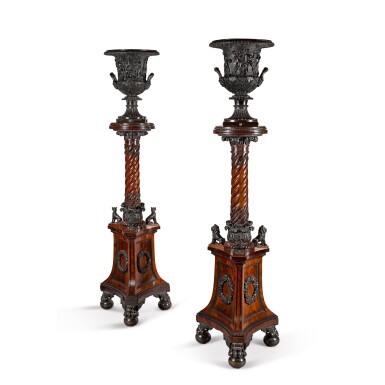
Property from an Important Private Collection
The Hamilton-Russell torchères
A pair of William IV bronze-mounted mahogany torchères, circa 1820
Lot Closed
April 11, 02:28 PM GMT
Estimate
18,000 - 28,000 GBP
Lot Details
Description
topped with associated Italian Medici-form bronze vases with friezes copied from the Borghese vase and the Medici vase, on square socles, early 19th century, the round tops of the torchères above columnar stems with twisted bronze-tongued fluting and with cast-bronze acanthus leaves to the capitals and base, the triangular base with bronze lions and dogs to the corners and centred by a bronze wreath, on bronze paw-and-ball feet
185cm high, 48cm. diameter at base; 6ft. ¾in., 1ft. 6 ¾in.
By descent in the Hamilton-Russell family, 46 Gloucester Place, Portman Square
Until purchased by their aunt Margaret Russell, Mrs. H.J. Allcroft in 1906, who noted in her inventory ‘A pair of Empire pedestals on tripod/support with/finely chased
bronzes/mounts £75 [and] A pair of bronze vases with belts of / baccharaka figures / and mask head / handles £30’
Sotheby’s, Stokesay Court, Ludlow, Shropshire, 28th September - 1st October 1994, lot 37
The form of these stands derives from the tall candelabra of Ancient Rome, which by the Regency were well documented: not only are six examples the focal point of the eponymous the Galleria dei Candelabri in the Vatican, which opened in the 1780s, but they featured prominently in the widely-circulated drawings of Piranesi.1 An example of the types of candelabrum that inspired this form are in the British Museum, 1805,0703.223, and the V&A also holds a carefully-realised drawing of one by Giuseppe Manocchi (c.1731-82), D.1495-1898. The design and execution of the present torchères are a clear example of the Regency as a late development of the Adam style: the tri-form base of these ancient candelabra was frequently used by Robert Adam as a base for candlesticks, torchères and pedestals for urns.2 Stands in the manner of the present lot rose in popularity during the early 19th century, though, particularly after the publication of C H Tatham’s Etchings of Ancient Ornamental Architecture in 1799.3 Related examples of Regency torchères in a similar form include the pair in the Drawing Room at Southill, dated circa 1808,4 a torchère illustrated in Reade’s Regency Antiques from circa 1810,5 and an example of broader proportions made for Henry Holland, based on a Tatham drawing.6
The bronze vases affixed to the torchères are likely associated, but also exemplify the archaeological aspect of Neoclassicism in Regency taste – the form and one frieze are based on the Medici vase, discovered in the 1570s and now housed in the Uffizi, inv. no. 1914 (Sculpture) no.307. As a remarkably fine and highly significant example of an ancient krater-form vase, it has been copied consistently since its excavation – this continued well into the Regency, when the vase was a popular reference point in neoclassical decoration. The great Regency silversmith Paul Storr, for instance, made silver-gilt copies of the Medici vase as wine coolers, with extant examples in the V&A (M.48 to B-1982), and in the Royal Collection (as part of the sumptuous Grand Service he made with Benjamin and James Smith for the Prince Regent in the early 1810s, RCIN 51289). The other frieze, depicting a Bacchanalian scene, is taken from the equally famous Borghese vase, which is now in the Louvre collections (MR 985 ; N 274 ; Ma 86)
1 Luigi Ficacci, Giovanna Battista Piranesi, Catalogo completo delle acqueforti, Cologne, 2016, pp. 644, 700, 703, 707.
2 See the two examples illustrated in Steven Parissien, Adam Style, London, 1992, p.129.
3 For an example of a candelabrum, see Charles Heathcote Tatham, Etchings, representing the best examples of ancient ornamental architecture : drawn from the originals in Rome, and other parts of Italy, during the years 1794, 1795 and 1796, New York, 1890, p.40. Available at: <https://cdm16028.contentdm.oclc.org/digital/collection/p16028coll4/id/32033> [accessed 25th January 2024]
4 Edward T. Joy, English Furniture 1800-1851, London, 1977, p.45.
5 Brian Reade, Regency Antiques, London, 1953, p.37, fig.34.
6 Francis Collard, Regency Furniture, Woodbridge, 1983, p.48.
